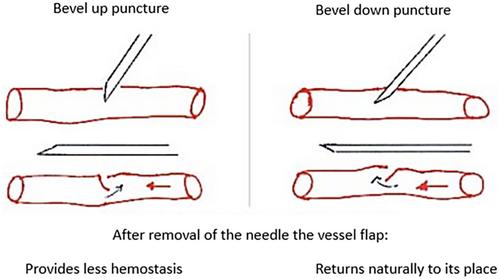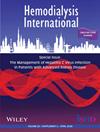Effect of needle orientation during arteriovenous access puncture on needed compression time after hemodialysis: A randomized controlled trial
Abstract
Background
There are two techniques for puncturing an arteriovenous fistula: one where the needle is inserted bevel up and then rotated to a bevel down position, and another where the needle is inserted bevel down. The aim of this study was to compare these two methods of needle insertion on minimum compression time required for hemostasis after needle removal.
Methods
This was a prospective, randomized, cross-over, blinded, single-center, routine care study. Each patient's average post-dialysis puncture site compression time was determined during a 2-week baseline period while using bevel-up access puncture. Subsequently, minimum post-dialysis puncture-site compression time was determined during each of two sequential follow-up periods, during which fistula puncture was done with needles inserted bevel up or down, respectively. The order of treatments (bevel up or bevel down insertion) was randomized. During each follow-up period, the minimum compression time necessary to avoid bleeding on needle removal was determined by progressively shortening the compression time. Puncture-associated pain was also assessed as prepump and venous pressures and ability to achieve desired blood flow rate during the dialysis session.
Results
Forty-two patients were recruited. The baseline compression time after needle removal averaged 9.99 ± 2.7 min During the intervention periods, the minimum compression time was on average 10.8 min (9.23–12.4) when the access needles had been inserted bevel down versus 11.1 min (9.61–12.5) when the access needles had been inserted bevel up (p = 0.72). There was no difference in puncture-associated pain between the two insertion techniques, and no difference in prepump or venous pressures or ability to achieve the desired blood flow rate during the dialysis session.
Conclusion
Bevel-up and bevel-down needle orientation during arteriovenous fistula puncture are equivalent techniques in terms of achieving hemostasis on needle removal, and puncture-associated pain.


 求助内容:
求助内容: 应助结果提醒方式:
应助结果提醒方式:


